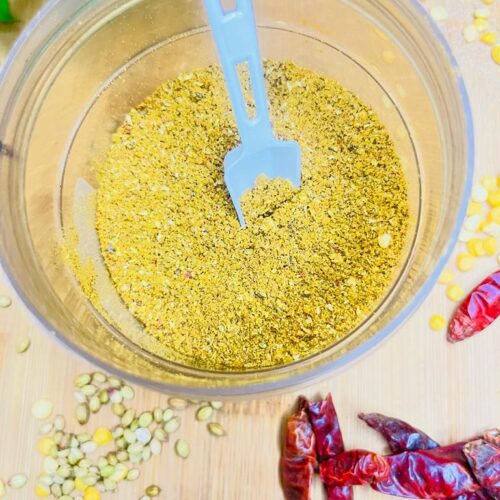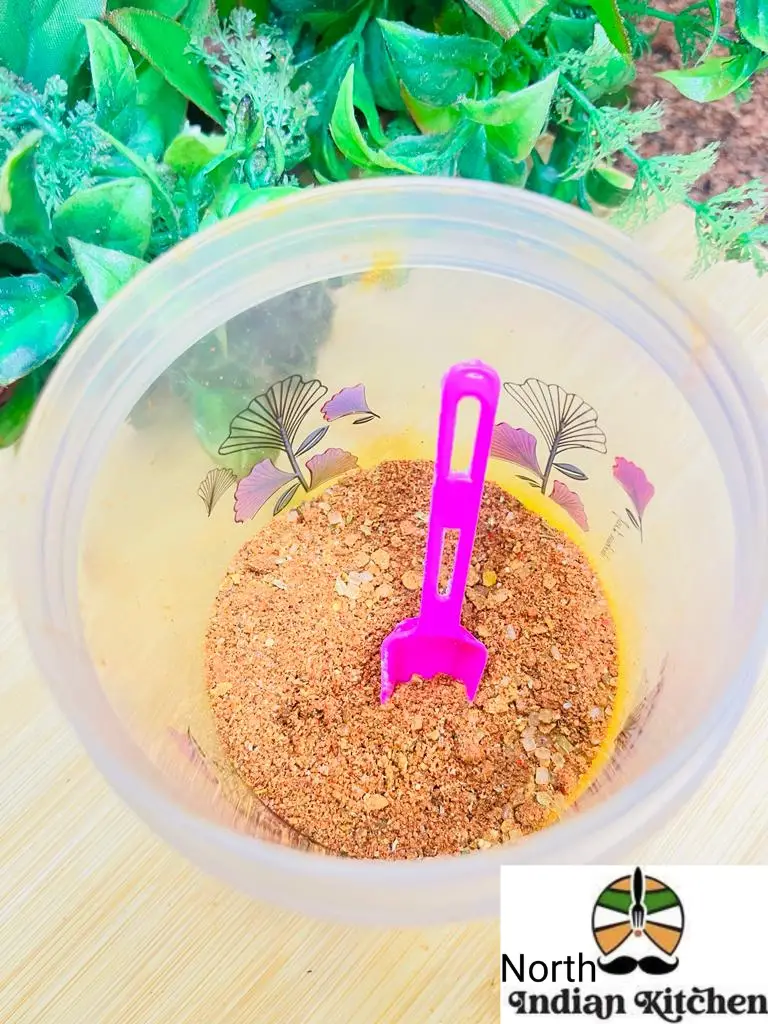Sambar Powder Recipe | Homemade Sambar Masala Powder | Sambar Podi
Sambar powder is a flavorful spice blend that is an essential ingredient in South Indian cuisine, particularly in the preparation of sambar, a popular lentil and vegetable stew. It is a versatile spice mix that adds depth, aroma, and a unique taste to various dishes. Sambar powder typically consists of a combination of roasted spices, which are ground into a fine powder. The specific ingredients and proportions can vary depending on regional preferences and individual recipes.
The primary purpose of sambar powder is to enhance the flavor and complexity of sambar. It brings together a harmonious blend of spices, creating a balanced and aromatic profile. The powder usually includes a variety of spices such as coriander seeds, cumin seeds, fenugreek seeds, black peppercorns, dried red chilies, curry leaves, and turmeric.
The preparation of sambar powder involves dry roasting the spices to unlock their essential oils and release their flavors. This step is crucial in developing the characteristic aroma and taste of the powder. The roasted spices are then ground into a fine powder using a spice grinder or mortar and pestle. The resulting sambar powder can be stored in an airtight container for future use.
Sambar powder not only adds depth to sambar but can also be used as a versatile spice blend in various other South Indian dishes. It can enhance the flavors of vegetable curries, lentil soups, rice dishes, and even snacks like vada and idli . The usage and intensity of sambar powder can be adjusted based on personal preference, allowing for customization in different recipes.
Making homemade sambar powder gives you the freedom to control the quality and freshness of the ingredients, tailor the spice levels to your liking, and create a blend that suits your taste preferences. It allows you to experience the authentic flavors of South Indian cuisine and add a touch of tradition to your cooking.
What is Sambar Masala
Sambar masala, also known as sambar powder or sambar spice mix, is a blend of spices used in the preparation of sambar, a popular South Indian lentil and vegetable stew. It is a key ingredient that imparts the distinct flavors and aroma to the dish. Sambar masala typically consists of a combination of roasted and ground spices, which are carefully selected to achieve a balanced and flavorful profile.
The spice blend is known for its complexity, combining earthy, tangy, and slightly spicy notes. It adds depth and richness to the sambar, making it a comforting and flavorful dish. Sambar masala is an integral part of South Indian cuisine and is used not only in sambar but also in various other dishes like rasam, vada, and vegetable curries.
Commercially prepared sambar masala is readily available in stores, but many households prefer to make their own homemade version. Making sambar masala at home allows for customization, as you can adjust the spice levels and ingredient proportions according to your taste preferences.
Whether store-bought or homemade, sambar masala adds a distinct and authentic flavor to South Indian dishes. It is cherished for its aromatic profile and the ability to elevate the taste of lentils, vegetables, and soups.

Tips For Best Homemade Spice Blends
Freshness of Spices: Start with fresh spices for optimal flavor. Whole spices retain their freshness longer than pre-ground spices, so consider grinding your spices from whole seeds whenever possible. If using pre-ground spices, make sure they are within their shelf life and stored properly.
Roasting: Dry roast the whole spices before grinding them. This process helps to unlock the essential oils and enhance the flavors of the spices. Roast the spices in a dry skillet over low to medium heat, stirring constantly until they become fragrant and slightly toasted. Be careful not to burn them, as it can give a bitter taste to the blend.
Cooling and Grinding: Allow the roasted spices to cool completely before grinding them. Grinding warm spices can result in moisture buildup and clumping. Use a spice grinder or mortar and pestle to grind the spices into a fine powder. It’s important to have a consistent texture to ensure even distribution of flavors.
Proportions and Balancing: Pay attention to the proportions of the spices in your blend. Balancing the flavors is crucial for a well-rounded and harmonious blend. Start with a basic recipe or guideline, but feel free to adjust the proportions to suit your taste preferences. Keep experimenting until you find the perfect balance of flavors.
Storage: Store your homemade spice blends in airtight containers to maintain their freshness and potency. Choose dark glass containers or metal tins that can protect the spices from light and moisture. Label the containers with the name of the blend and the date of preparation for easy identification.
Quality of Ingredients: Choose high-quality spices and herbs for the best results. Purchase from reputable sources and consider using organic spices whenever possible. Quality spices will provide more intense flavors and aromas, enhancing the overall taste of your spice blends.
Customization: Don’t be afraid to get creative and customize your spice blends. Add or omit ingredients based on your preferences and experiment with different combinations. Personalize the blends to match your desired flavor profiles and the specific dishes you plan to use them in.
How to make Sambar Powder
- Heat a dry skillet or pan over low heat, add 1/2 cup coriander seeds and roast them for a few time.

- After roast for sometime, transfer coriander seeds to a plate and kept it aside.

- Now add 2 tablespoons cumin seeds and roast it on same pan for sometime.

- Append 2 tablespoons chana dal and roast it.

- Make sure that dal should roast very carefully as it will burn if we give some extra time.

- Put 1 tablespoon black peppercorns in pan and give sometime to get roast.

- Now add 1 tablespoon urad dal for roast.

- Again make sure that roast this dal also very carefully.

- Append 16-18 dried red chilies into the pan for roasting.

- Add 1/3 cup curry leaves and roast it until it turn aromatic.

- Be careful not to burn them.

- Now put 1/2 tablespoon mustard seeds in the pan.

- Last but not the least add 1/2 tablespoon asafoetida to get roast.

- Remove the pan from heat and collect all the roasted spices in one plate and let them cool down.

- Afterwards transfer the spices in a medium-sized bowl and append1/2 tablespoon turmeric powder.

- Once cooled, transfer the roasted spices to a spice grinder or mortar and pestle. Make sure that finely grinding should be done. Grind the spices into a fine powder. You can sieve the powder to remove any coarse particles for a smoother texture.

- Transfer the sambar masala powder to an airtight container and store it in a cool, dry place.

Your homemade sambar masala is now ready to use. Add it to your sambar and other South Indian dishes to enhance their flavors. Adjust the quantity of sambar masala according to your taste preferences and the spiciness level desired. Enjoy the authentic flavors of homemade sambar with your freshly prepared masala.
Expert Tips
Choose Quality Spices: Start with fresh, high-quality spices when preparing sambar masala. Using stale or low-quality spices can affect the taste and longevity of the masala. Look for reputable spice brands or consider sourcing whole spices and grinding them yourself for maximum freshness.
Roast and Cool Properly: Ensure that you roast the spices adequately and allow them to cool completely before grinding and storing. Roasting helps to release the essential oils and intensify the flavors. Cooling prevents condensation and moisture buildup, which can lead to clumping or spoilage.
Store in Small Batches: It’s best to store sambar masala in smaller quantities rather than a large batch. This helps maintain freshness since you’ll be opening the container less frequently. You can make smaller portions and replenish them as needed to ensure the flavors remain vibrant.
Use Airtight Containers: Invest in high-quality airtight containers made of glass, stainless steel, or food-grade plastic. Ensure the containers have secure lids that seal tightly to prevent air and moisture from entering. Avoid using containers that may absorb odors or allow light to pass through, as they can affect the quality of the masala.
Keep Away from Heat and Light: Store the sambar masala in a cool, dark place away from direct sunlight, heat sources, and moisture. Exposure to heat and light can accelerate the degradation of spices and reduce their shelf life. A pantry or a cabinet away from the stove or windows is a suitable storage spot.
Avoid Contamination: Use clean, dry spoons or scoops when handling sambar masala to prevent contamination. Moisture and foreign particles can introduce bacteria or cause clumping. Keep the container tightly closed when not in use to minimize exposure to air and humidity.
Date and Rotate: Label the container with the date of preparation and, if desired, the expiration date (around 6 to 8 months). This allows you to track the freshness of the masala and helps with rotation, ensuring you use the oldest batch first.
FAQs
Q: How long does homemade sambar masala last?
A: Homemade sambar masala can last for about 6 to 8 months when stored properly in an airtight container in a cool, dark, and dry place. However, its flavor and potency may diminish over time. It’s best to use it within this timeframe for optimal taste.
Q: Can I freeze sambar masala?
A: It’s not necessary to freeze sambar masala as it can be stored at room temperature. Freezing may cause condensation and affect the quality of the spices. It is recommended to store it in a cool, dry place instead.
Q: Can I store sambar masala in the refrigerator?
A: While sambar masala can be stored in the refrigerator, it is not necessary unless you live in a particularly hot and humid climate. Storing it in a cool, dark pantry or cabinet is usually sufficient. Refrigeration may introduce moisture, which can cause clumping.
Q: Can I use expired sambar masala?
A: It is generally advisable not to use expired sambar masala. Over time, the flavor, aroma, and potency of the spices may diminish, resulting in a less flavorful sambar. It’s best to prepare a fresh batch or purchase a new one to enjoy the authentic taste.
Q: Can I adjust the spice levels in sambar masala?
A: Yes, you can adjust the spice levels in sambar masala to suit your taste preferences. Increase or decrease the quantity of red chilies or other hot spices to make it spicier or milder, respectively. Adjusting the spices allows you to customize the masala according to your preferred heat level.
Q: Can sambar masala be used in other dishes?
A: Yes, sambar masala can be used in various other dishes to enhance their flavors. It can be added to lentil-based curries, vegetable dishes, rice preparations, and even snacks like vada and idli. Its versatile nature allows you to experiment and add a touch of South Indian flavor to different recipes.
Q: Can I use store-bought sambar masala instead of homemade?
A: Yes, you can use store-bought sambar masala as a convenient alternative to homemade. Many brands offer pre-packaged sambar masala with a blend of spices. However, the flavors may vary, so adjust the quantity according to your taste preferences and the desired spiciness level.
Try our Other Spice’s Recipes
Please be sure to rate this recipe or leave a comment below if you have made it. For more vegetarian & non – vegetarian inspirations, Sign Up for my emails or follow me on Instagram, Youtube, Facebook, Twitter or Pinterest.
Sambar Powder Recipe Card
Equipments
Ingredients
- ½ cup Coriander seeds/40grams coriander seeds
- 2 tablespoons Cumin seeds
- 16-18 Dry Chilies
- 1½ teaspoon Fenugreek seeds (methi seeds)
- 1 tablespoon Black Pepper
- 2 tablespoon Chana Dal (split husked bengal gram)
- 1 tablespoon Urad Dal (split husked black gram)
- ⅓ cup Curry leaves
- ½ tablespoon Mustard seeds
- ½ tablespoon Asafoetida (hing)
- ½ tablespoon Turmeric powder
Instructions
- Heat a dry skillet or pan over low heat, add ½ cup coriander seeds and roast them for a few time.2. After roast for sometime, transfer coriander seeds to a plate and kept it aside.3. Now add 2 tablespoons cumin seeds and roast it on same pan for sometime.4. Append 2 tablespoons chana dal and roast it.5. Make sure that dal should roast very carefully as it will burn if we give some extra time.6. Put 1 tablespoon black peppercorns in pan and give sometime to get roast.7. Now add 1 tablespoon urad dal for roast.8. Again make sure that roast this dal also very carefully.9. Append 16-18 dried red chilies into the pan for roasting.10. Add ⅓ cup curry leaves and roast it until it turn aromatic.11. Be careful not to burn them.12. Now put ½ tablespoon mustard seeds in the pan.13. Last but not the least add ½ tablespoon asafoetida to get roast. 14. Remove the pan from heat and collect all the roasted spices in one plate and let them cool down.15. Afterwards transfer the spices in a medium-sized bowl andappend ½ tablespoon turmeric powder.16. Once cooled, transfer the roasted spices to a spice grinder or mortar and pestle. Make sure that finely grinding should be done. Grind the spices into a fine powder. You can sieve the powder to remove any coarse particles for a smoother texture.17. Transfer the sambar masala powder to an airtight container and store it in a cool, dry place.Your Sambar Masala Powder is ready
Video
Notes
- Homemade sambar masala allows you to have control over the flavors and freshness of the spices used. It can be customized to suit your taste preferences.
- Ensure that all the spices used in the sambar masala are fresh and of high quality for the best results.
- Roasting the spices before grinding enhances their flavors and aromas.
- Allow the roasted spices to cool completely before grinding to avoid moisture buildup.
- Store sambar masala in airtight containers in a cool, dark, and dry place to maintain its freshness and potency.
- Label the container with the name and date of preparation for easy identification and to track its freshness.
- Use clean, dry utensils when handling sambar masala to prevent contamination.
- Check the sambar masala periodically for any signs of spoilage, such as clumping or off odors, and discard if necessary.
- Adjust the spice levels in the sambar masala according to your preference by increasing or decreasing the quantity of hot spices.
- Homemade sambar masala can be used not only in sambar but also in various other dishes to add a South Indian flavor.
- While homemade sambar masala can last for several months, it's recommended to use it within 6 to 8 months for the best flavor.








